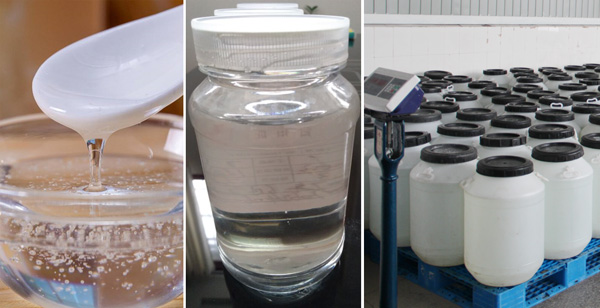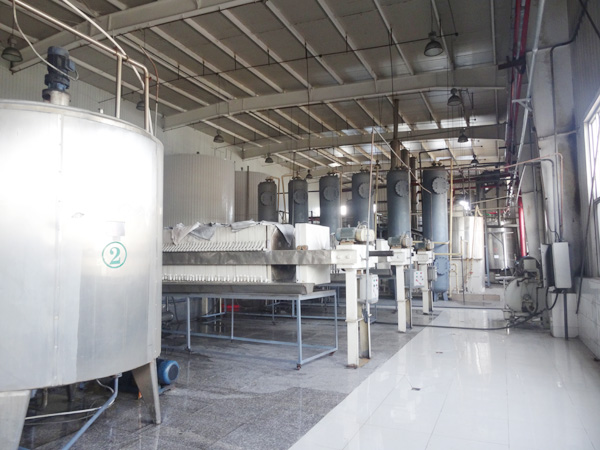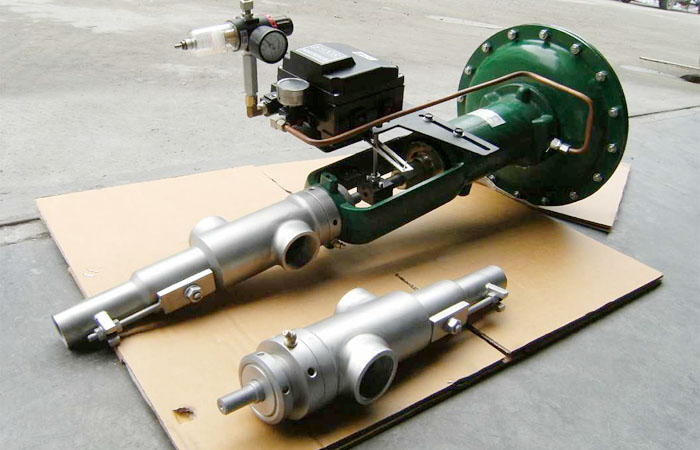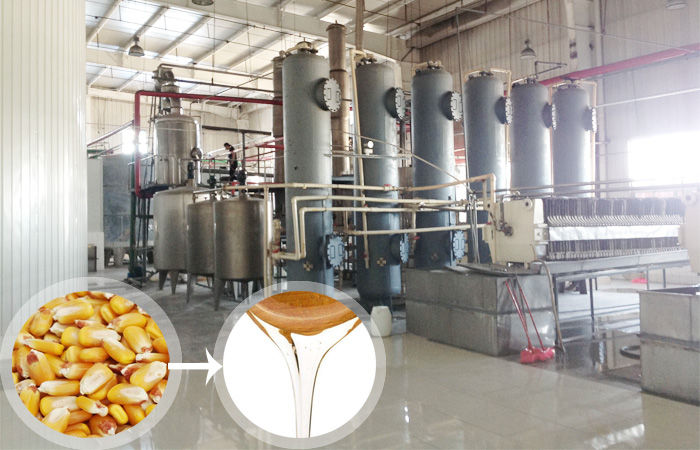Sterilization and pollution prevention in glucose syrup processing
2018-09-13
/Syrup Processing
In recent years, production of starch and glucose syrup processing in China has developed rapidly. However, most enterprise pay attention to the improvement of production capacity, when it comes to quality examination, they only pay attention to the general chemical testing, but pays little attention to microbial contamination. Therefore the product quality cannot meet the requirements, especially for the glucose that will be used as food or drugs. Here bellow introduces the sterilization and pollution prevention when glucose syrup processing is proceed.
Environment control in glucose syrup processing:
As for environmental regulations, generally production area is divided into general area, control area and clean area. The clean level is >100000, 100000 and 10000, the particle size of dust is <0.5μm, and the number of grains is ≤35000/L, 3500/L and 350/L respectively. The colony number control area should be ≤10, and the clean area should be ≤3. The starch glucose syrup end product area can refer to the requirements of the control area, with temperature at 18 ~ 28 ° C, humidity 50% ~ 55% and air changes 15 times / h.

Syrup
Product quality and hygiene requirements in glucose syrup processing:
Although the original starch has no hygienic requirements, as a pharmaceutical excipient, the oxidized substance should be <0.002%, total aerobic bacteria <1000pc/g, mold <100pc/g. Starch products and starch glucose requires the total number of bacteria <500 and 1500 pc/g, and the total number of bacteria required for maltose and maltose dextrin <3000pc/g. No coliform and pathogenic bacteria is allowed.
Antibacterial and anti-pollution measures of glucose syrup processing:
1. Raw material
Raw materials of glucose syrup processing include starch, enzyme agent, decolorization agent, filter aid agent, acid and alkali, process water, etc. All the related materials should achieve food or drug requirements.
2. Equipment
In the glucose syrup processing, all food contact part should be made of stainless steel, in case that there is unnecessary pollution.

DOING syrup equipment
3. Production procedures
(1) Prevent growth of yeast. Most starch glucose is kind of sugar that is easy to breed yeast. For example, in the ion exchange part of glucose syrup processing, residual sugar is not rinsed and due to temporary or long-term production stop of device, sugar liquid storage tank and activated carbon storage tank will breed yeast if the temperature is suitable after use. Fermentation will cause the loss of sugar dry matter, and seriously affect the quality of finished glucose product. Therefore, necessary measures should be taken: soak idle ion exchange columns with regenerant agent and maintain temperature above 80° C. (Usually when temperature is above 80° C , it's not easily to ferment)
(2) Enzyme deactivation. In the glucose syrup manufacturing process, various enzymes will be applied for starch hydrolysis. Some enzymes interfere with each other, therefore former enzyme must be killed before we add the next enzyme. At the same time, when the enzyme act on the substrate excessively, the non-killing enzyme will have the opposite effect, which cause lower purity of end product. Generally, the pH can be adjusted to 4.5 to make enzyme inactivated, and temperature is heated to 80 ° C for 10 minutes to kill the glucoamylase.
(3) Keep clean environment. The ground should not be covered with sugar, and the plant should be sealed to prevent mosquitoes, flies, insects, ants, dust and rats from entering.
(4) Finished product packaging. After the evaporation of glucose syrup processing is finished, it's better to make liquid glucose sterilized before packaging. Besides, liquid glucose should be filtered by stainless steel membrane, so as not to cause color deepening phenomenon.
Environment control in glucose syrup processing:
As for environmental regulations, generally production area is divided into general area, control area and clean area. The clean level is >100000, 100000 and 10000, the particle size of dust is <0.5μm, and the number of grains is ≤35000/L, 3500/L and 350/L respectively. The colony number control area should be ≤10, and the clean area should be ≤3. The starch glucose syrup end product area can refer to the requirements of the control area, with temperature at 18 ~ 28 ° C, humidity 50% ~ 55% and air changes 15 times / h.

Syrup
Product quality and hygiene requirements in glucose syrup processing:
Although the original starch has no hygienic requirements, as a pharmaceutical excipient, the oxidized substance should be <0.002%, total aerobic bacteria <1000pc/g, mold <100pc/g. Starch products and starch glucose requires the total number of bacteria <500 and 1500 pc/g, and the total number of bacteria required for maltose and maltose dextrin <3000pc/g. No coliform and pathogenic bacteria is allowed.
Antibacterial and anti-pollution measures of glucose syrup processing:
1. Raw material
Raw materials of glucose syrup processing include starch, enzyme agent, decolorization agent, filter aid agent, acid and alkali, process water, etc. All the related materials should achieve food or drug requirements.
2. Equipment
In the glucose syrup processing, all food contact part should be made of stainless steel, in case that there is unnecessary pollution.

DOING syrup equipment
(1) Prevent growth of yeast. Most starch glucose is kind of sugar that is easy to breed yeast. For example, in the ion exchange part of glucose syrup processing, residual sugar is not rinsed and due to temporary or long-term production stop of device, sugar liquid storage tank and activated carbon storage tank will breed yeast if the temperature is suitable after use. Fermentation will cause the loss of sugar dry matter, and seriously affect the quality of finished glucose product. Therefore, necessary measures should be taken: soak idle ion exchange columns with regenerant agent and maintain temperature above 80° C. (Usually when temperature is above 80° C , it's not easily to ferment)
(2) Enzyme deactivation. In the glucose syrup manufacturing process, various enzymes will be applied for starch hydrolysis. Some enzymes interfere with each other, therefore former enzyme must be killed before we add the next enzyme. At the same time, when the enzyme act on the substrate excessively, the non-killing enzyme will have the opposite effect, which cause lower purity of end product. Generally, the pH can be adjusted to 4.5 to make enzyme inactivated, and temperature is heated to 80 ° C for 10 minutes to kill the glucoamylase.
(3) Keep clean environment. The ground should not be covered with sugar, and the plant should be sealed to prevent mosquitoes, flies, insects, ants, dust and rats from entering.
(4) Finished product packaging. After the evaporation of glucose syrup processing is finished, it's better to make liquid glucose sterilized before packaging. Besides, liquid glucose should be filtered by stainless steel membrane, so as not to cause color deepening phenomenon.
Leave A Message About Sterilization and pollution prevention in glucose syrup processing
- Director: Ms Elina Wu
- Phone: 0086 135 2661 5783
- WhatsApp: 0086 135 2661 5783
- Tel: 0086 371 5677 1822
- sales@syrupmachine.com
- Chat Online
- Ion exchange resin equiped in ion exchange column, its necessary for t...
- When high maltose corn syrup is produced in industrial production,the ...
- Here bellow introduces the sterilization and pollution prevention when...
- And we can install the corn syrup plant fou you.Corn syrup is produced...
- Corn syrup production steps introduce the way of how to make glucose s...
- The liquid glucose manufacturing process completed by one complete set...
- Corn syrup production process is a process of converting corn into syr...
- DOING adopt the modern and advanced technology for liquid syrup manufa...
- Starch syrup manufacturing process introductions and the main equipmen...
- Syrup evaporator is key equipment in glucose production line,there are...


